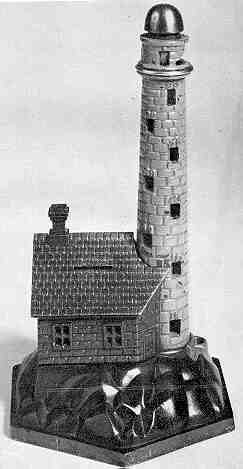The Lighthouse Bank
by F.H. Griffith - HOBBIES Magazine - July, 1973
 The Lighthouse, a most attractive bank, is our choice at this time
as No. 225 in the numerical classification. For some years, until fairly recently this
mechanical improperly remained in the so-called semi-mechanical group. This group
consisted of only 16 banks, 15 of which were actually still banks. The Lighthouse has
similar operation to that of two recognized mechanicals, the Safety Locomotive and the
Thrifty Animal Bank, plus an additional operation that is not part of either of these
banks. This has to do with putting coins in the bank — you don’t just drop or
push them in the slot.
The Lighthouse, a most attractive bank, is our choice at this time
as No. 225 in the numerical classification. For some years, until fairly recently this
mechanical improperly remained in the so-called semi-mechanical group. This group
consisted of only 16 banks, 15 of which were actually still banks. The Lighthouse has
similar operation to that of two recognized mechanicals, the Safety Locomotive and the
Thrifty Animal Bank, plus an additional operation that is not part of either of these
banks. This has to do with putting coins in the bank — you don’t just drop or
push them in the slot.
The Lighthouse shown is really an outstanding example of this bank, all original and no repairs. It is truly in mint condition, a pleasure to see, and one of the finest known to exist. The bank, circa 1890’s, fits into the fine Tudor collection like a glove and Wally takes great pride in displaying it among his other mechanicals, quite a few of which are in equal condition. He, like Ed Mosler, the writer, and several other advanced collectors, continually upgrade their banks whenever possible. This is a very important, meaningful part of the challenge of collecting the mechanicals and a true part of the seriously interested discriminating collector. In here comes a genuine liking and appreciation of each individual bank — not just a surface feeling of possessing something regardless of its condition.
A misconception exists among some collectors with respect to the use of pennies in the tower of the Lighthouse. It does not hold just 100 pennies, which are incorrectly used anyway, but in fact will take 125. Those that feel pennies should be used are under the wrong impression in that they think the numbered windows in the tower designate the number of cents therein. These numbered windows in fact do show how many coins are stacked in the tower, however, they are nickels, not pennies. The bank was made to operate properly with nickels only — if pennies are used the numbered windows do not show the proper number of coins.
The colors of the Lighthouse are simple, but effective. The rock-like base and building are a japanned or varnish-like finish. The tower is red and the various numbers over the windows are gold. The sliding drawer-like coin trap is also red. The top operating knob and the ring just under it are nickel plated. The ring, by the way, holds the two-part tower together at the top. It is held together at the bottom by two lugs which also serve to hold the tower in place.
To operate the bank, a nickel is pushed into the slot at the top of the tower. Then the knob is pressed forcing the coin to drop down the tower. The nickel is held in place at the top by two short inward bent flat springs on each side of the inside of the tower. The knob presses the coin through the springs. The springs serve the purpose of not allowing any coins to be removed from the coin slot. A coin once inside the tower cannot be shaken or otherwise maneuvered back up to the slot.
The number of nickels are shown by the numbered windows. One side of the tower is in even numbers — 10, 30, 40, 60, 70, 80, and 90. The other side has 15, 35, 45, 65, 75, and 85. After the deposit of 98 to 100 nickels the top knob is pressed and this activates a spring in the drawer like coin trap at the bottom of the tower allowing the trap to be pulled out by its handle.
The bank has another coin slot in the roof of the building and coins may be deposited therein. There is a round trap under the building for removal of coins saved in this fashion. So actually the Lighthouse is a combination of two banks in one — a still bank and a mechanical — since in each case coins are saved in different and separate compartments, each with its own coin trap. A somewhat unique situation in a mechanical since it would have overtones of interest to strictly still bank collectors as well.
